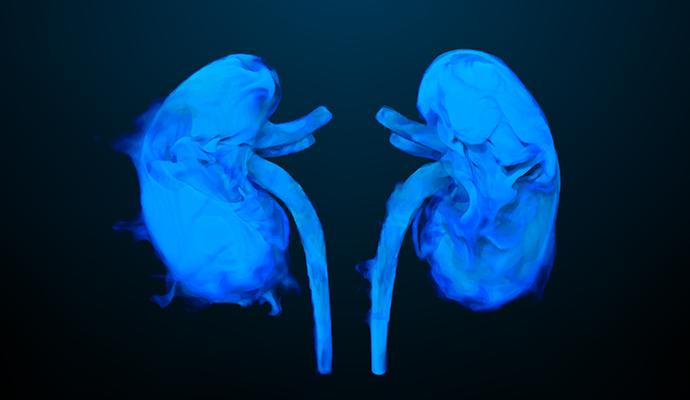Treatment Could Boost Acute Kidney Injury Risk Prediction, Prevention
Targeting individuals with elevated levels of a specific protein could help improve risk prediction and prevention of acute kidney injury.

Source: Getty Images
High levels of soluble urokinase plasminogen activator receptor (suPAR), a protein produced by immune cells in the bone marrow, could inform risk prediction and prevention of acute kidney injury (AKI), according to a study published in the New England Journal of Medicine.
AKI is a potentially life-threatening condition that is often difficult for providers to detect. Up to ten percent of patients who are hospitalized or undergo surgery will experience AKI, researchers noted. As many as 50 percent of patients in intensive care units will meet the criteria for AKI, some of whom will progress to kidney failure within months.
Previous research has shown that suPAR can cause harm to kidneys and is linked to the development of chronic kidney disease. A team from Rush Medical Center examined suPAR levels and the risk of acute kidney injury in three clinical settings.
“We collected blood samples from patients about to undergo coronary angiography for suspected heart disease, patients undergoing cardiac surgery, and critically ill patients who had been admitted to the intensive care unit,” said David E. Leaf, MD, a co-first author on the study and the director acute kidney injury research at Brigham and Women’s Hospital of Harvard Medical School.
The results showed that suPAR levels independently predicted risk of AKI in each of these clinical settings. If a person had higher suPAR levels before undergoing coronary angiography or cardiac surgery, or upon admission to the intensive care unit, they were at much greater risk of developing AKI afterwards.
Researchers found that these associations were entirely independent of other clinical characteristics, including age, race, gender, severity of illness, and baseline kidney function. The team then divided patients into quartiles based on how high their suPAR levels were and compared outcomes across patient groups.
The findings revealed that risk of AKI increased steadily with increasing suPAR levels, with an increase of 3.5 to four times the risk of AKI for those in the highest quartile compared to the lowest. High suPAR levels consistently predicted AKI in these patients.
“In this study, we found evidence that suPAR is a strong risk factor for acute forms of kidney failure, that occur as consequence of general medical procedures,” said Jochen Reiser, MD, PhD, a professor at Rush University Medical Center and chairperson of Rush’s Department of Internal Medicine.
In the second phase of the study, researchers used mouse models of AKI to determine whether high suPAR is actually a contributing cause of the condition. When the team exposed mice to contrast used in patients undergoing coronary angiography, they found that higher levels of suPAR resulted in worsening of kidneys compared to mice with normal levels.
“We are studying interventions to alter suPAR levels,” said Reiser. “We found that when mice were pretreated with a monoclonal antibody to block suPAR, the researchers managed to reduce the development and the severity of kidney injury.”
The researchers are seeking to leverage treatments and medications already used for other purposes, such as statins or immune modulators, to improve AKI therapy. However, they have also accelerated the development of novel humanized suPAR antibodies that will be evaluated in clinical trials.
“We have known for some time now of suPAR’s important role in kidney disease. Here we show that suPAR is relevant in important clinical situations such as coronary angiography and cardiac surgery, and could be targeted to minimize the risk of AKI,” said Salim Hayek, MD, a cardiologist at the Michigan Medicine Frankel Cardiovascular Center and first author of the study.
The team expects that high suPAR levels will inform physician-patient conversations about preventing kidney disease, and will lead to better risk prediction for the condition.
“Nephrology has found its global risk molecule: suPAR,” Reiser concluded.
“Any kidney disease, chronic or acute, genetic or acquired, is better off with a lower suPAR level. By looking at suPAR levels in patients, we can possibly prevent damage to healthy kidneys that is often irreversible.”
